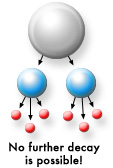fundamental? The modern atom model The scale of the atom What are we looking for? The standard model The standard model quiz
|
Weak
 
There are six kinds of quarks and six kinds of leptons. But all the stable matter of the universe appears to be made of just the two least-massive quarks (up quark and down quark), the least-massive charged lepton (the electron), and the neutrinos. Weak interactions are responsible for the decay of massive quarks and leptons into lighter quarks and leptons. When fundamental particles decay, it is very strange: we observe the particle vanishing and being replaced by two or more different particles. Although the total of mass and energy is conserved, some of the original particle's mass is converted into kinetic energy, and the resulting particles always have less mass than the original particle that decayed. The only matter around us that is stable is made up
of the smallest quarks and leptons, which cannot decay any further.
When a quark or lepton changes type (a muon changing to an electron, for instance) it is said to change flavor. All flavor changes are due to the weak interaction. The carrier particles of the weak interactions are the W+, W-, and the Z particles. The W's are electrically charged and the Z is neutral. The Standard Model has united electromagnetic interactions and weak interactions into one unified interaction called electroweak. |






















